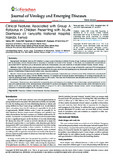| dc.contributor.author | Gatinu, BW | |
| dc.contributor.author | Kiulia, NM | |
| dc.contributor.author | Nyachieo, A | |
| dc.contributor.author | Macharia, W | |
| dc.contributor.author | Nyangao, JO | |
| dc.contributor.author | Irimu, G | |
| dc.date.accessioned | 2016-06-08T07:20:44Z | |
| dc.date.available | 2016-06-08T07:20:44Z | |
| dc.date.issued | 2016 | |
| dc.identifier.citation | Journal of Virology and Emerging Diseases, Volume: 2.1 2016 | en_US |
| dc.identifier.uri | http://dx.doi.org/10.16966/jved.112 | |
| dc.identifier.uri | http://hdl.handle.net/11295/96076 | |
| dc.description.abstract | Background: Worldwide rotavirus (RV) infection is a major cause of diarrhea in children <5 years of age. Continual monitoring of RV prevalence
and its associated clinical characteristics is necessary to estimate the burden of the disease. In this study, we evaluated the clinical features
associated with RV diarrhea such as dehydration and levels of electrolytes, urea and creatinine at Kenyatta National Hospital, Nairobi, Kenya.
Methods: A total of 192 diarrheic stool samples were collected from children under 5 years of age and tested for presence of RV using enzyme
immunoassay (EIA). A further 92 blood samples collected from the same cohort but only targeting severely dehydrated children, were used for the
analysis of electrolytes (Potassium and Sodium ions), urea and creatinine.
Results: Rotavirus was detected in 53.4% (103/192) of stool specimens. Dehydration was common in most of the children who presented with
diarrhea regardless of RV status (172/192; 89.6%). However, RV patients had increased duration and frequency of vomiting compared with non
rotavirus patients but levels of dehydration were similar in both groups. There was loss of electrolytes and elevated levels of both urea (>7.5mmol/l)
and creatinine (>80μmol/l) in all severely dehydrated cases.
Conclusion: Rotavirus was associated with increased duration and frequency of vomiting, but loss of electrolytes and elevated levels of both
urea and creatinine were similar among severely dehydrated RV positive and negative children. This study provides useful information to policy
makers on RV that could, together with other studies in Kenya on RV, aid in understanding the disease burden, earlier clinical diagnosis and
evaluation of cost benefit analysis for RV vaccines in Kenya. | en_US |
| dc.language.iso | en | en_US |
| dc.rights | Attribution-NonCommercial-NoDerivs 3.0 United States | * |
| dc.rights.uri | http://creativecommons.org/licenses/by-nc-nd/3.0/us/ | * |
| dc.subject | Rotavirus | en_US |
| dc.subject | Children | en_US |
| dc.subject | Clinical features | en_US |
| dc.subject | Diarrhea | en_US |
| dc.subject | Electrolytes | en_US |
| dc.title | Clinical Features Associated with Group A Rotavirus in Children Presenting with Acute Diarrhoea at Kenyatta National Hospital, Nairobi, Kenya | en_US |
| dc.type | Article | en_US |



